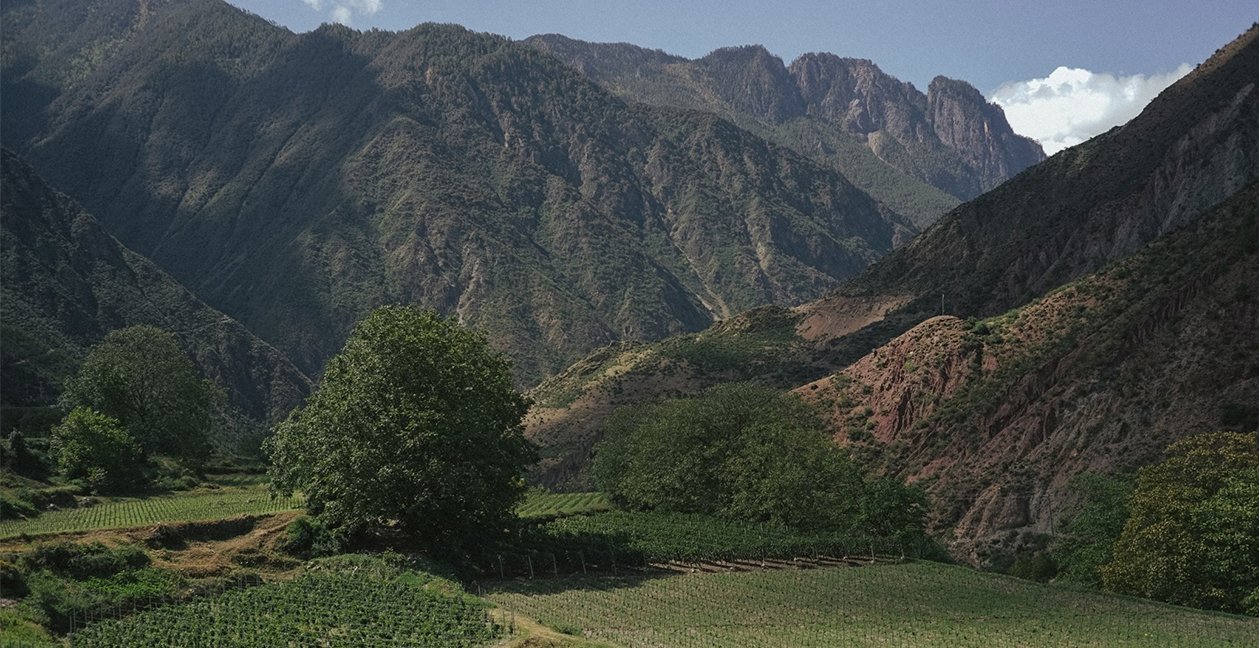Once upon a time, Shangri-La was a fiction, a longed-for paradise of harmony and happiness. Invented by British writer James Hilton in the 1933 novel Lost Horizon, it was a mythic utopia, a blissful valley somewhere in Asia’s Kunlun Mountains, hidden in, yet apart from the world. It’s not inconceivable that such a place could have had a vineyard. In 2001, the Chinese government renamed Zhongdian County, a majority-Tibetan region, Shangri-La City in an attempt to promote tourism. For about the past five years, despite enormous obstacles of transportation and logistics, this Shangri-La does, in fact, have a winery.
The vineyards of Ao Yun—the name means “flying above the clouds” in Mandarin—rest on rock terraces 8,500 feet up in the Himalayas, in a remote part of China near where the Yangtze, Mekong and Salween rivers meet. For LVMH (Louis Vuitton Moët Hennessy), the luxury goods conglomerate that founded and owns the winery, Ao Yun has been as audacious as it has been costly and arduous. With China’s “consuming class” now numbering 1.2 billion and the world entering what consultancy McKinsey calls the “age of Asia,” Ao Yun may also prove to be an incredibly prescient venture for LVMH. It is certainly a very expensive gamble.

It’s not easy to visit Ao Yun. I arrived at Diqing/Shangri-La airport 40 hours and three flights after leaving my home in the Napa Valley. “Descend” doesn’t really describe what planes do in this remote corner of the Himalayas. Tossed around by air currents rebounding off the walls of glaciers and gorges, the plane finally jolted onto a small, high plateau that offered barely more than a sense of ground.
A man named Tashi, whom Ao Yun had arranged to drive me, was waiting. A Buddhist, Tashi had a cherubic face and curious earlobes that jutted perpendicularly from the sides of his head. He told me that his lama, or spiritual teacher, said that these were signs that Tashi had, in a former incarnation, been an important lama himself. All the workers at Ao Yun are Buddhist, Tashi explained. Because of this, they had “inner peace,” and under their care, the vineyards of Ao Yun were doing well.
The next morning, after some yak butter tea (the best method for keeping warm, Tashi insisted), we set off for Adong, the tiny village where Ao Yun is located. Until a new highway opened last year, this journey took eight hours, winding slowly between enormous yaks ambling along the narrow mountain paths. No words can describe the vertigo induced by these near-vertical “roads” of endless hairpin turns and thousand-foot drops on either side. Tashi said not to worry, no one ever gets injured in a car accident here. You’re either OK, or it’s your time.

///
LVMH’s first hire for the Ao Yun project was the famous Australian winemaker Tony Jordan. It was Jordan’s task to comb China’s 3.7 million square miles in search of a site that could yield grapes capable of resulting in a Chinese wine equal to a first-class Bordeaux. (Sadly, he died last August of cancer, at age 75). The goal: to create a domestic luxury product that would appeal to Chinese consumers. With one-third of production going to the U.S. and another third to France, LVMH is simultaneously trying to show the rest of the world that it can make a phenomenal new addition to the global pantheon of great wines. “It has always been in Moët Hennessy DNA to be one step ahead,” says Boris Janicek, managing director, estates and wines, the Moët Hennessy wine division.
When Jordan began his search, in 2008, a few very good wines, especially cabernet sauvignons, were already being made in China—notably in Ningxia, just south of Mongolia and the Gobi Desert in central China, as well as on Shandong Peninsula in northeastern China, immediately south of the Korean Peninsula, where Château Lafite Rothschild had bought land.
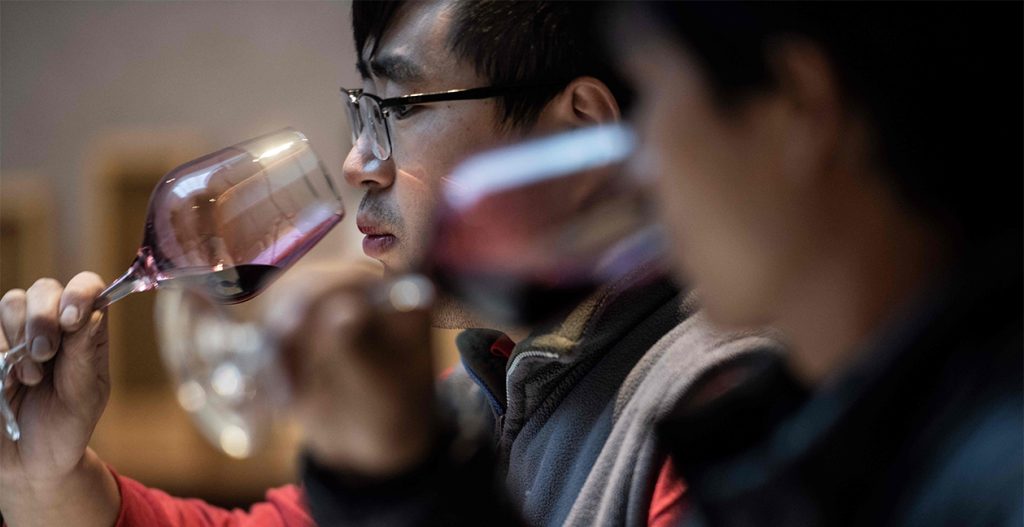
But Jordan was unconvinced. Ningxia was hot, and the grapes there often suffered from too much heat and sunburn. Shandong, burdened by summer monsoons, was humid, and the vines would be threatened by mildew and fungal diseases. Jordan wanted a dry climate, with a lot of daytime sun but nighttime coolness, and the kinds of rocky, low-water-holding soils that vines thrive in.
In 2010, he paid the Chinese government to gather weather data on a small area in the Himalayas where French missionaries had planted grapes in the 19th century, and where the Chinese government itself had established a few vineyards in the 1980s and 1990s to provide the local Tibetan peasants with another source of income beyond yak products and barley.
The place Jordan had found was nearly impossible to reach except by ancient tea trading roads, dusty slivers that ran between what was then known as Zhongdian and Lhasa, the capital of the Tibet Autonomous Region. Depending on their ethnic background, the locals spoke more than nine different languages, which meant that work orders from LVMH headquarters or from Jordan himself would need to be translated from French into English, then into Chinese, then into a slew of Tibetan languages. The place he envisioned for the winery had plenty of wolves, bears and yaks, but no running water and no electricity. The air was so thin that he suspected grapes wouldn’t ferment in a normal way. There were no suppliers of barrels, bottles, tanks or even wineglasses. The Tibetans usually didn’t deal in cash, and there were no banks in the villages.
Otherwise, as the location for a world-class winery, Adong village was perfect.
///
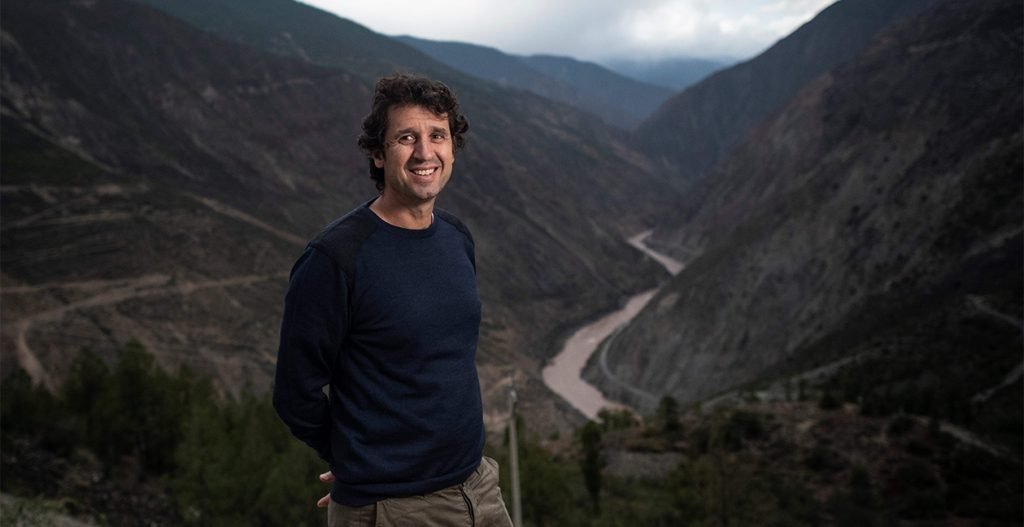
October 2018. Photo by Fred Dufour / AFP via Getty Images)
Maxence Dulou looks like he walked off the cover of GQ. Dark-haired, slender and a little scruffy, he was ping-ponging around wineries in Bordeaux, Chile and South Africa after graduating from oenology school when, in 2013, LVMH offered him the job as Ao Yun’s “technical director”—basically, part winemaker, part estate manager. Dulou, a native of the Sauternais region in France, was intrigued. So he, his Chilean wife and their two small children packed up and moved to Adong, sight unseen.
To describe his first few years as culture shock, says Dulou, would be an understatement. The vineyards LVMH had leased from the Chinese government turned out to be already leased by more than a hundred local Tibetan families, but Dulou, who doesn’t speak Chinese or Tibetan, didn’t know which plots were worked by which families. (LVMH’s Chinese lawyers worked out a creative lease with both the government and the local families.) Dulou needed the families to do the day-to-day vineyard work and harvest the grapes. But the Tibetans seemed unmoved by orders coming out of offices someplace in the 8th arrondissement of Paris. Whole families would disappear for days, suddenly and without warning, sometimes in the middle of harvest, and travel to higher mountain forests to hunt for mushrooms—the area is famous for shiitakes, which the Tibetans sell to the Japanese—or to take their yaks up to feed.
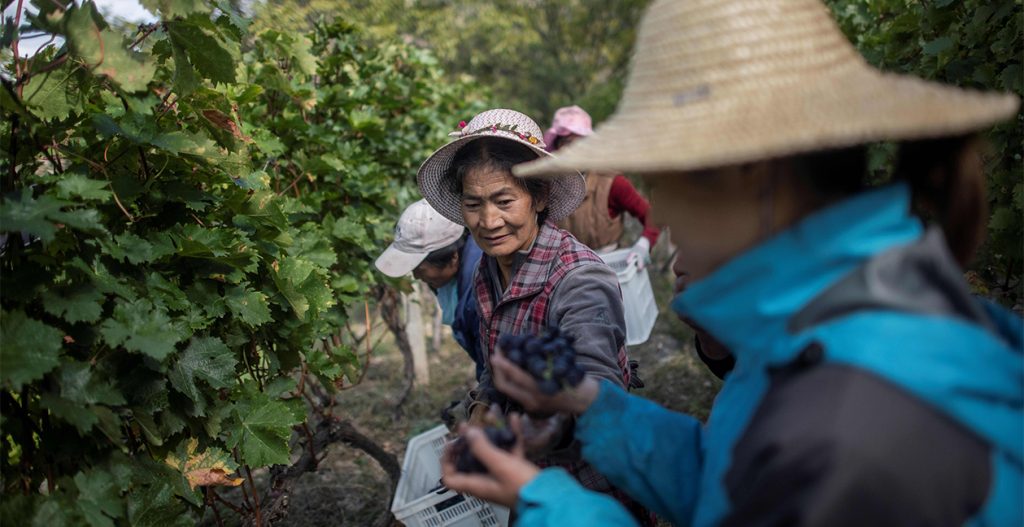
Over several years, Dulou made it work. He developed a bonus system: Locals would get paid for coming to work, for beginning to work, for doing the work well and for finishing on time. He also forged close ties to the head of each village and his family, who were key conduits to all the other families. “The Chinese have a capacity to cause problems,” he says, adding with admiration, “and a fantastic capacity to solve them.”
Ao Yun now has 69 acres (28 hectares) of organic vines—most on their own roots, not planted on rootstock, as are 99 percent of the vines in the world. (Vines growing from their own roots are thought to be stronger than those grown from rootstock.) Simple handmade trenches capture snowmelt for irrigation. The vineyards are spliced by rows of barley, which Dulou gives to the families to feed their yaks. In return, the families give Dulou yak droppings to use as natural fertilizer on the vineyards.
Before dinner (yak hot pot) on one night during my visit in December, we went to the winery to taste Ao Yun’s four vintages: 2013 to 2016. Unlike Château Lafite Rothschild’s recently opened winery in Shandong, Ao Yun has no portraits of ancestors or impressive barrel cellars to be admired by guests. Wedged onto a menacing cliff face, Ao Yun is unadorned and nondescript. It annually produces some 2,000 cases of wine, bottled in custom-designed bottles flown and carted in from France. As more vineyards are planted and come online, production may increase to 5,000 cases a year.
Because they are modeled on Bordeaux blends, the Ao Yun wines are principally cabernet sauvignons, blended with cabernet franc, sometimes a bit of merlot, and in the latest vintage still in barrel, petit verdot and syrah (the last is not a Bordeaux variety but a brilliant addition nonetheless, as the rich, spicy syrah contributes to the blend).
For a winemaker, everything rides on getting a blend spot-on. Early on, Dulou agonized constantly. Because of the ultradry air and diminished oxygen, it’s difficult to smell and taste at 8,500 elevation. He now makes the first trial blends at the winery, then flies wine samples down to sea level and makes the blend again, just to be sure it’s right.
As the tasting went on, the personality of the Ao Yun wines emerged. Like the mountains around them, these are dark, monolithic, ragingly powerful wines. Yet they also have an underlying core of freshness that gives them a sense of vibrancy. You could hide Ao Yun in a blind tasting of Napa Valley cabernets and no one would suspect a thing.
///
LVMH’s 2019 purchase of Tiffany for $16.2 billion was the largest acquisition the luxury retailer had ever made. The New York Times noted that LVMH hadn’t just bought an American jeweler—it had purchased part of American culture.
With Ao Yun, LVMH has done more than just build a winery. In a similarly Machiavellian manner, it has threaded itself into Chinese culture by capitalizing on the people’s exploding desire for luxury products—in this case, a luxury product of their own.
Last July, McKinsey released a report titled Asia’s Future is Now. According to the report, Asia accounted for nearly one-third of global GDP in 2000. Within the next 20 years, it’s expected to top 50 percent. Also by 2040, Asia will account for 40 percent of the world’s consumption, representing what the report calls a “real shift in the world’s center of gravity.” A key part of Asia’s breakneck economic advancement going forward, the report says, will be the development of “more sophisticated products” that will be sold locally instead of to the West.
“Thirty-five years ago, virtually everyone in China was quite poor,” says Christopher Beros, Asia director of the California Wine Institute. “The consumption of luxury products is how new wealth and success are communicated. It’s hard to think of a world-class luxury product other than wine that could be produced in China and get global recognition so quickly.”
Global recognition has come within just a few years, with prestigious wine journals taking note of the new vintages. Profit, however, will take longer—a quarter-century, Dulou says. LVMH can afford to wait. And in the meantime, Ao Yun has sister products that may prove to be beneficiaries. A high-end Chinese wine that can compete with the finest reds in the world just might have a halo effect when it comes to selling Dom Pérignon Champagne, Christian Dior dresses, Givenchy perfume, Bulgari watches, Tiffany diamonds and dozens of other LVMH products. Launching Ao Yun “was a very wise move by LVMH,” says Beijing-based master of wine Fongyee Walker.
On the last day of my visit, Dulou invited me to Ao Yun’s harvest lunch, a concept previously unknown in Shangri-La. In a community hall decorated only with posters of Mao Zedong, Xi Jinping and other Chinese leaders, about 80 people, some holding prayer wheels, sat on small benches at two long, low tables—one for men, the other for women and children. As people chatted and sucked on sunflower seeds, spitting the shells on the floor, they passed around $300 bottles of Ao Yun, drinking it from paper cups. Soon, servers were spooning out yak soup from a large plastic bucket on the floor. Dulou stood up to toast the village chief and a few governmental officials who had joined the lunch. He talked about creating the perfect Chinese product.
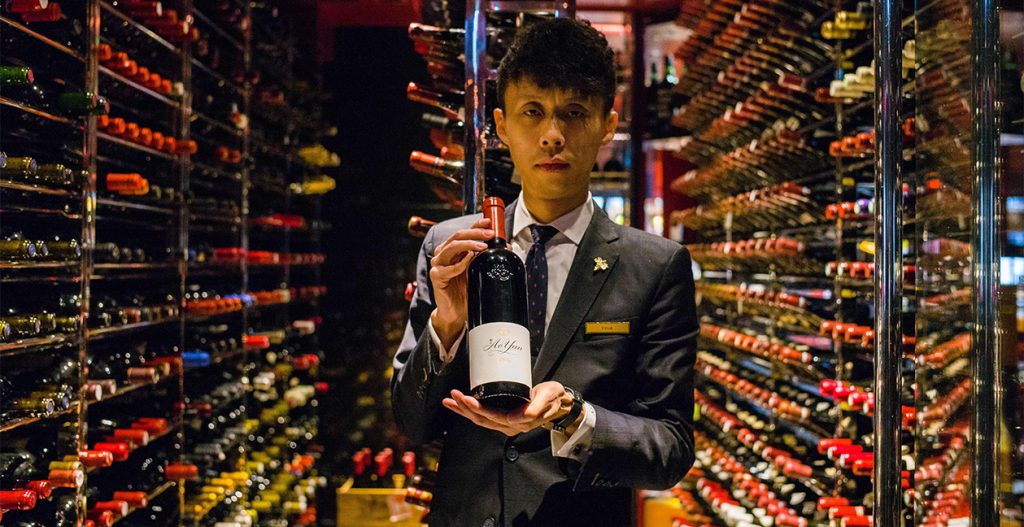
After his toast, he turned to me. “Two years ago, people thought, ‘Who the hell do they [LVMH] think they are?’ ‘Made in China’ meant something shitty. But now, people take us seriously.”
He looked out the window at the forbidding, snow-covered peaks. “The Chinese culture has allowed us to progress quickly,” he said. “The Chinese are creative. Unlike the French, they aren’t afraid of change. And they aren’t afraid to move mountains.”

